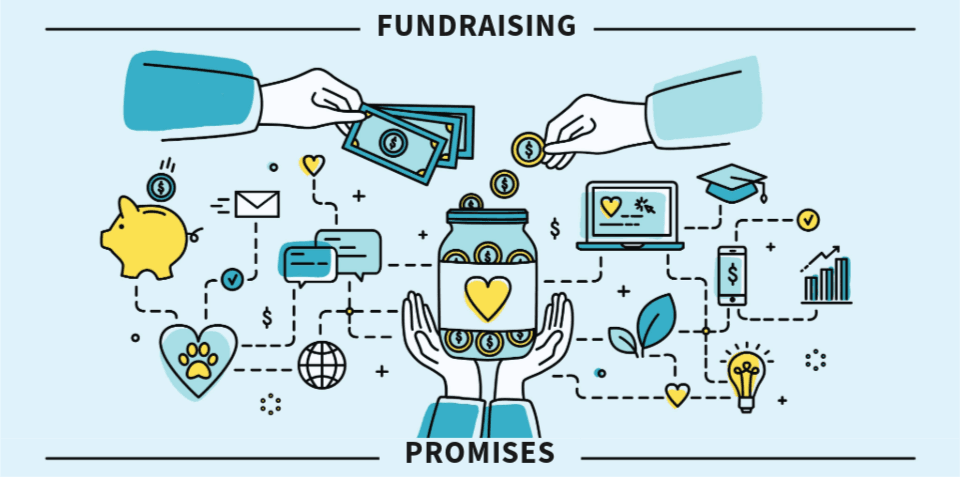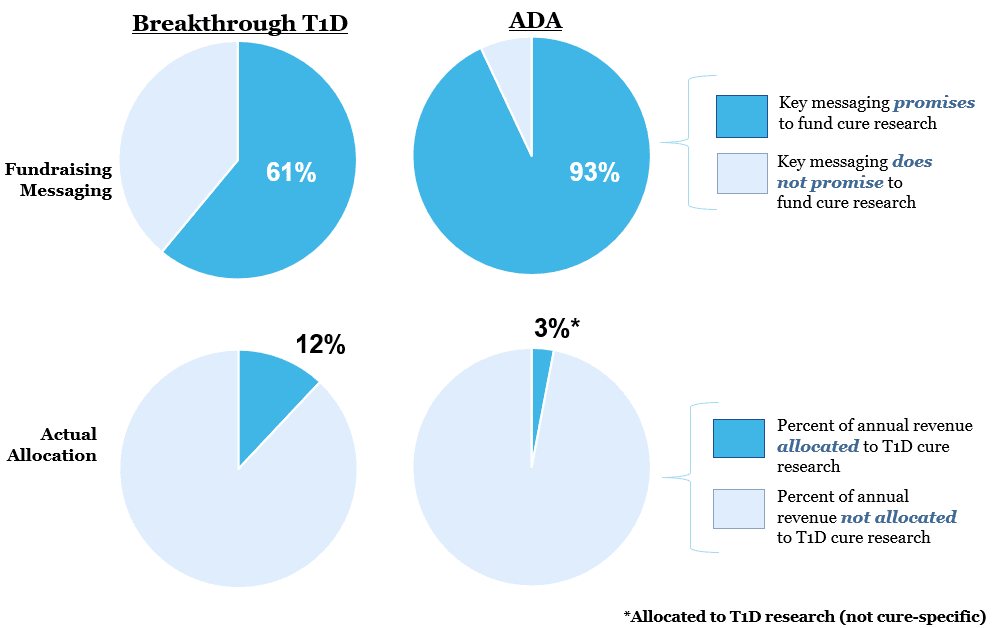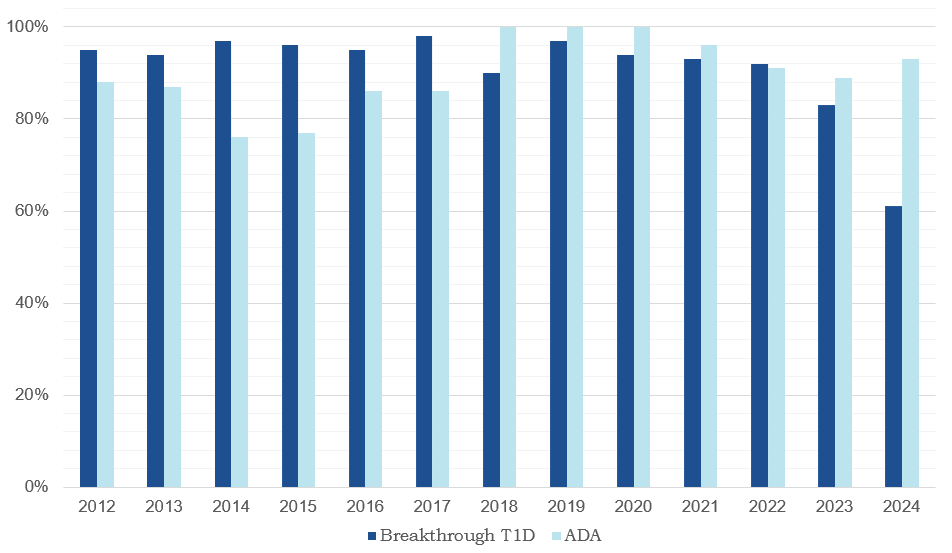
At a Glance
- Breakthrough T1D and the ADA held a combined total of 289 fundraising events.
- The majority of fundraising events promise to deliver a cure, but less than 15% of revenue is actually used for a T1D cure.
- 61% of Breakthrough T1D’s events promise a cure; only 12% of revenue is used for cure research.
- Only the CEO, Aaron Kowalski, and the board can change this lack of alignment between promise and actual use.
- 93% of the ADA events promise a cure; only 3% of ADA revenue goes to T1D research (a general lack of financial transparency makes cure-specific T1D research impossible to determine).
- ADA remains primarily focused on T2D and resists increasing support for T1D.
September 26, 2024
Diabetes nonprofits maintain hefty calendars of fundraising events, drawing members of the T1D community year-round to participate in annual walks, rides, galas, and other unique activities.
The generosity of hosts, donors, and participants leads to millions of dollars raised each year. Diabetes nonprofits depend on these fundraising events. As a result, they craft messaging designed to attract the most donations possible. For the T1D community, there is no message more attractive than promising the proceeds will fund a T1D cure.
This is the JDCA’s 13th annual report comparing advertising messages utilized by Breakthrough T1D (formerly JDRF) and the American Diabetes Association (ADA) to actual cure research funding. This year, the organizations held 289 events combined.
To conduct this analysis, JDCA reviewed both organizations’ 2024 event calendars. In particular, the team counted the number of events that used fundraising messages suggesting proceeds would fund cure research. Publicly available IRS Form 990s from fiscal year 2023 (FY23) were reviewed to deduce how much money was made from fundraising events and what percentage of the organization’s revenue went toward T1D-cure research.
Chart 1: Cure-Focused Messaging Compared to Actual Cure Funding

Key Findings
Financial information is in regard to FY23.
Event-advertising information is in regard to 2024.
Breakthrough T1D ‘Breaks’ from Cure
Since 2012, the vast majority—80% or more each year—of Breakthrough T1D fundraising events promised to fund cure research (see Appendix A). These events used taglines like “Turn type one into type none,” and “A world without T1D.” Year in and year out, cure was the primary fundraising message.
This year, however, there was a clear strategic shift. Breakthrough T1D has started broadening the scope of its messaging to cover a range of areas, some outside of research entirely. While the majority of events still featured a cure-focused message, the amount lowered to 61%. Larger galas still used the cure promise as the primary message with “Fund a Cure” segments, but the national walks and rides were broadened and watered down. The numbers:
- 261 events in 2024.
- 61% featured cure-specific messaging.
- 100% of galas feature cure-specific messaging.
- $224 million: Breakthrough T1D’s revenue in FY23 ($102 million from events).
- 12% of Breakthrough T1D’s revenue was allocated to cure research (+6% increase from the prior year).
Walks and rides mostly replaced ‘cure’ as their objective with a broader and less focused promise. The majority of messaging is muted, such as: “We’re walking to power more research, enable more advocacy, and fund more support” and “By joining the Breakthrough T1D Walk, you will help us create a movement to improve and change life with type 1 diabetes, advancing life-changing breakthroughs on the way to cures.” Where the cure message was front and center in prior years, it is relegated to a near afterthought in 2024.
Why is Breakthrough T1D backing away from cures when it remains the number one reason people participate in fundraising activities?
It is presumed that this change is in accordance with JDRF rebranding to Breakthrough T1D earlier this year, focusing on improving the day-to-day of T1D on the way to an eventual cure, as opposed to cure research being the focal point. But this is a risk. If Breakthrough T1D is no longer the nonprofit that is making the pursuit of a T1D cure its top priority, those who donate to expedite a T1D cure will be drawn elsewhere. We see this as a potentially massive strategic shift.
Who can put Breakthrough T1D back on the cure track?
In JDCA’s 2023 Executive Compensation report, Breakthrough T1D’s CEO, Aaron Kowalski, was in the top 1% of nonprofit earners in the US, holding the position of 8th highest-paid nonprofit CEO in the comparison. (Note: The next annual Executive Compensation report will be published in October.) Only the well-respected Aaron Kowalski and the board of directors, who have the fiduciary duty to keep the organization on mission, can make the shift to re-prioritize cure research, the sole focus when the organization was founded in 1970.
This shift can be pushed forward by members of the T1D community. If you want a cure to be the focus, speak out. If donors insist their contributions be used to fund cure research specifically, nonprofits are obligated to follow.
ADA Raises Money with Cure Promise but Remains Uncommitted to T1D
Unlike Breakthrough T1D, the ADA continued to use the cure promise as its primary message in over 90% of its events, similar to prior years (see Appendix A). Their most common promises are rallying cries to “Stop T1D” and events titled “Tour de Cure.”
The numbers:
- 28 events in 2024.
- 93% featured cure-specific messaging.
- $137 million: ADA’s revenue in FY23 (10 million coming from events).
- 3% of ADA’s revenue was spent on any type of T1D research in FY23.
The ADA is no longer transparent about how it uses its research dollars (a shift from prior years). Research grant funding is included in IRS Form 990s by default, but the grant center on ADA’s website does not specify how much money is given to each project, unlike Breakthrough T1D. Though it can be determined that the ADA spent 3% of its revenue on T1D research in FY23, it is not possible to determine how much was spent specifically on cure research. This is a missed opportunity, as nonprofit financial transparency fosters trust, something the ADA risks losing in the T1D community.
Fundraising Promises Must Be Fulfilled
Supporting cure research is by far the number one reason people participate in fundraising events. This has been true for the past twelve years that the JDCA priority survey has been conducted. In this year’s survey, 98% of respondents said that a cure is the most important reason they participated in a fundraising event.
When most of us participate, fundraise, host, or donate directly to fundraisers and events, we assume that our contributions will be used for cure research. Event messaging promises tug on heartstrings, rallying the community together in the fight against T1D, because nonprofits know that a cure is what the T1D community values most.
Despite this, only a small portion of dollars are used for cure research and Breakthrough T1D is backing off focusing on cure. These are real concerns.
It is time for fundraising promises to align with donor intentions.
Appendix A: Percentage of Events That Use Cure-Based Messaging (13-Year Trend)

